
Blur
Written by: Rik
Date posted: January 18, 2023
- Genre: Racing
- Developed by: Bizarre Creations
- Published by: Activision
- Year released: 2010
- Our score: 9
It may or may not still be the case, but at some point in the last 10 years or so, the high-profile arcade racer became one of the many gaming genres to be declared ‘dead’ by the press and public. At the time of writing, Forza Horizon seems to be the dominant franchise, with the majority of other racing titles seemingly more simulation focused, and the occasional flickers of life from the Need for Speed series one of the few remaining big names from generations past.
Certainly, the commercial failure of Blur was cited as a significant factor in the shutdown of Bizarre Creations by publisher Activision, a decision that seemed moderately surprising to many observers who might reasonably have assumed that the studio’s impressive CV, including the Project Gotham Racing series that became a flagship for successive generations of Xbox hardware, would have afforded them some credit in the bank and a little more patience. And Blur was well-enough received critically, even if it was more a case of slightly reserved praise and 8/10s rather than the 9s and 10s that were perhaps anticipated.
Of course, the commercial fates of games are largely sealed long before the Johnny-come-lately, wait-for-the-Steam-sale types such as myself deign to open our virtual wallets and pay under £6 to see what all the fuss may or may not have been about several months or years ago. By my own standards, though, checking something out 12-18 months or so after release isn’t too bad, and it came as some surprise to subsequently find that the studio that made it had already been shut down by its corporate overlords.
Blur was a pleasant recurring feature of one particularly cold, family-free Christmas at home in 2011, the type of which it might be said these days that ‘goblin mode’ had been fully engaged, with niceties such as getting dressed and eating normal food at normal times being abandoned in favour of chocolate and bottled beer between the hours of 11am-7pm, watching rubbish on TV and playing games all day. (It’s not a dignified existence, certainly not for any longer than a few days, but sometimes these things are necessary).
Your correspondent even saw fit to sing Blur‘s praises and use it to advertise his engagement with (relatively) modern gaming on the famous gaming site A Force for Good. Shortly after which, for unknown reasons, it was then put down and not picked up again. And so, ten years later, we belatedly return, with the question of whether (in line with FFG best practice guidelines) we should abandon previous progress and start over again soon rendered redundant by the discovery that the old save files did not, in fact, survive the transition to a new PC.
‘Mario Kart with BMWs and neon’ would be a lazy, but fairly accurate, way to describe Blur, an arcade caper with a clear focus on multiplayer fun, to the extent that a rapidly-going-out-of-fashion split-screen option was included for those unable or unwilling to delve into the various network options. However, even though Stoo and I did have a brief taste of Blur‘s local multiplayer on the Xbox 360 some years ago (he’d never played it before and I’d completely forgotten what was involved, so it wasn’t a classic encounter), we are (as usual) going to ignore that element of the game in favour of detailing the single-player experience.
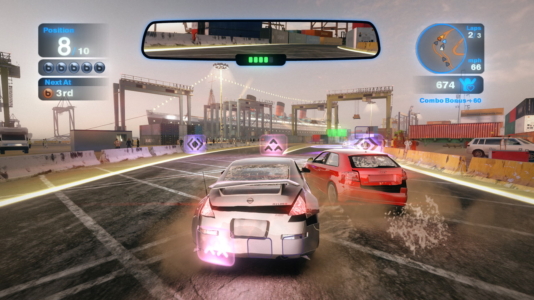
A certain amount of visual damage is displayed, although for an accurate reading it’s the bars on your rear view mirror you need to pay attention to.
While browsing through the 10 million or so screenshots taken in the course of this latest playthrough, it occurred to me that in stills Blur may come across as an excessively busy game, with the chaos of the main action made even more baffling by incessant on-screen notifications, implying a nightmare of drip-fed tutorials and jargon, as a breathy voice-over woman pauses the action to tell you what the game’s cool new name for drifting is. There is, as it happens, a breathy voice-over woman, but she appears only in menu interludes and cut-scenes that are mercifully brief, and the game is in fact incredibly intuitive, allowing you to learn by doing.
The structure of the solo career mode involves meeting a series of challenges to unlock a ‘boss’ encounter. Usually the challenge involves doing well in races, although there are sundry other supplementary requests that also require attention. Aside from races – laps against a full grid, a combo of racing and combat – there are also solo checkpoint races against the clock, as well as a Destruction mode that involves the elimination of drone vehicles to earn points and keep the clock running.
Each challenge comes with a number of individual sub-targets, known in the game as earning ‘lights’. In a race event, lights are earned for finishing first, second or third; in the others, target times or scores are set. Additional lights are available for meeting a target of ‘fans’ – these are points awarded for driving with style and/or panache, a la Project Gotham’s Kudos system (at least here it’s Bizarre ripping themselves off) – and for completing a specific ‘fan run’, a timed gate challenge that can be found and unlocked during each race.
In other words, finishing third or meeting the lowest target in the race will ‘complete’ it, but for maximum lights you need to do better in the race, pull off a few extra moves to earn fans, and make sure to unlock and complete the fan run along the way. And everything is configured in such a way that even those who are usually reluctant to ‘100%’ everything before moving on are likely to be sucked in: maxing out your lights never seems out of reach, and another go at just doing a little bit better is more tempting than it is taxing.
Race events embody the full mayhem of Blur. The combination of racing and weapons is not always a tempting dish, but this is a great example of near-perfect execution. It’s laps around a closed track, but with alternate routes, and a manageable selection of well-balanced pickups, including nitro, shield, various weapons, and repair. Of the weapons, Barge sends out a shockwave that repels vehicles in your immediate vicinity; Bolt gives you three shots to destabilise an opponent in the distance; a Mine is, well, a mine; Shock creates electrical hazards on the track for the vehicles at the front of the pack to negotiate; and Shunt is a great flaming ball of red trouble that locks on from a distance and sends an opponent flying upon making contact.
Some mastery of what to use and when, allied to a fairly aggressive approach, is required to survive and succeed. Each weapon has a secondary fire mode, in most cases allowing you to fire backwards with a flick of the D-pad, or – when using mines – flinging it forward towards opponents rather than leaving it behind you on the track. While at first you may come to consider the Shunt as a massively overpowered weapon, and dread the tell-tale sound and flashing warning that one will soon be looming up behind you, there are actually a number of ways to avoid being hit without being in possession of a shield, and even if a last-second swerve out of the way might be a little tricky to pull off under pressure, you can also use the Barge just prior to contact, fire some Bolt shots behind you, or drop a Mine, to deflect the Shunt away and continue racing.
You can hold three items at any time, all of which are displayed by your vehicle’s bumper while racing, and you can switch between them using the shoulder buttons and drop those that are unwanted at any point. Pickups regenerate in the same spot, and so you can also plan to take a certain route if you’re in particular need of something, e.g. an urgent repair – although as it turns out, total destruction sees you regenerate with a time penalty rather than ending your race altogether. (Similarly, if you drive off the track or veer too far off course, the game will automatically reset you, which is slightly immersion breaking, but probably for the best in terms of keeping the game moving at all times).
One of the challenges for a combat-based racer is to neglect the actual racing, but here you do have to drive well, too. If, for example, you start focusing too much on the additional demands of a particular boss character – for example they want you, for some reason, to achieve x number of successful Bolt hits, or some other niche request – you can find yourself way out of contention for a place in the top three. And while it’s certainly an arcade game, the vehicles are more than just interchangeable avatars, and come with the sense of weight and heft you’d expect from a studio with serious racing pedigree (although possibly the steering is a little too heavy at times).
Vehicle choice is also key, with Blur retaining the good, old-fashioned, visual menu bars representing speed, acceleration, handling, etc. that provide the player with a useful summary of each vehicle’s merits. Again, selection quickly becomes intuitive, and it soon becomes easy to tell whether a change of car might make that extra difference, or whether you have the best one already and are just being crap. ‘Do I need the extra speed on this course, or is handling more important?’ is a very real choice here. Finding a good all-rounder and sticking with it is not really an option, although it’s true that, from the vast number that ultimately become available, you’re likely to have a fairly small selection of favoured vehicles that you switch between.
Tinkering becomes particularly important on the Checkpoint and Destruction solo challenges, both of which are technically against the clock, and represent a pared-down and more focused distillation of some of Blur‘s core elements. They’re no less engaging for it, though, with route, racing line, and the choice between time bonuses and nitro pickups (the only ones available) being crucial in Checkpoint events, and skill with the Bolt weapon the key factor in Destruction. In each, you still have the fan targets to meet, and fan runs to unlock and complete, which are a bit more tricky to prioritise when you’re up against time constraints, but it all remains eminently possible.
All racing games are repetitive to some extent [Almost as repetitive as your assertion that all racing games are repetitive – Ed.] but how Blur is different is perhaps best summed up by the fact that the mid-race ragequit/restart – a hallmark of the genre – was maybe used fewer than five times across the 20 or so hours I spent with the game. Somehow, it always keeps you in touch with possible success, and any rubber band AI tricks it uses to this end are well-hidden rather than obvious and patronising. The decision to have another go at a race is usually a positive one, rather than the more aggressive, joypad-smashing, oh-I-can’t-believe-this-goddamn-game type choice. (Plus the game makes it very easy, even allowing you to quickly switch to another vehicle at this point rather than going back to the menu). At no stage did I feel the grind of reluctantly chewing through a series of repetitive and similar races; and neither is it a tale of starting with a shite car and eventually progressing to the better ones – things are unlocked more quickly, and the game shifts between different performance classes throughout, mixing up events and their requirements.
Boss races are one-on-one challenges, in the same vehicle as your opponent. You either have to finish ahead of them, or wipe them out with your weapons, with their vehicle and some kind of bonus upgrade to a particular pickup (for example, an extra Bolt hit, or a shield that also hammers opponents if they get near you, that you can activate during subsequent races) offered up as a reward. Compared with the rest of the game, they’re a little bit uneven, with some being stupidly easy to overcome, and others – I’m thinking the downhill race against two Nissan Skylines, in particular – being as hard as nails.
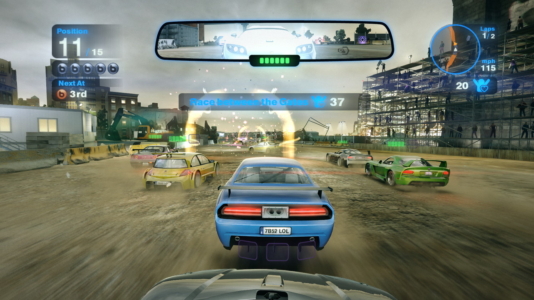
Taking on a fan run during lap one: worth a go, but potentially tricky with all that traffic around.
The boss/story element is perhaps the weakest part of Blur. The notion of characters and personalities existing in this world is slightly underdeveloped, with the player character an anonymous beardy man and opponents being represented by a menu picture and brief videos that attempt to introduce each one. (It turns out the breathy voice-over is provided by Danica Patrick, a professional racing driver, which seems like a bit of a waste of a featured celebrity appearance, if you’re going to have one). Sometimes, the more context you attempt to introduce, the more you start to ask questions about what isn’t explained, e.g. why exactly there are real-life BMWs driving around near real-life Brighton pier that have the mysterious capability to summon bursts of electrical energy from nowhere.
However, that gripe, and one or two slightly piss-takey targets and fan runs towards the end aside, are pretty much the only things to complain about here. I suppose I did also spot one or two graphics glitches – like visual damage on your car from the previous attempt at a race being evident when you restart – and at times you do notice that some of the detail on background models and textures has been sacrificed, presumably in the name of speed, which stand out only because this is otherwise a rather swish-looking game.
I do have a particular weakness for the kind of challenge Blur presents to the player: a series of arcade racing events that say, ‘Come on, see if you can do this’ that are all set up and balanced in a way that mean that if you can’t quite do it at first, you nearly can. If you happen to be similarly-inclined, then the process of going from ‘nearly’ to ‘can’ over and over again during the course of this game will be about as much fun as it’s possible to have.
If we were in a different version of the past, an alternate 2010, in which I somehow found myself writing about the latest new releases in a self-consciously detached manner for a professional outlet, I might fashion some clever-sounding line about the muted presentation and riotous action seemingly being uneasy bedfellows but ultimately blending successfully for Blur to mark a triumphant new chapter in Bizarre’s history. [Poor! – Ed.] Or I might instead have been an up-to-the-minute hardcore gamer, confident in expressing his opinions to any unwitting audience in weird transatlantic dudespeak, in which case I would have had no hesitation in striding into the local Computer Exchange, waving a finger at the nearest member of staff behind the counter and exclaiming, ‘You played Blur, mate? What a fuckin’ game, dude! What a game, man!’
As we are, though, in the cold and bleak winter of 2023, stood forking through the wreckage of abandoned games old and new, let this uncool and ageing amateur, from a position of relative safety and absent any jeopardy associated with the outcome, make the simple recommendation that, if you missed Blur back then, you check it out now, if you can. I don’t think you’ll regret it.

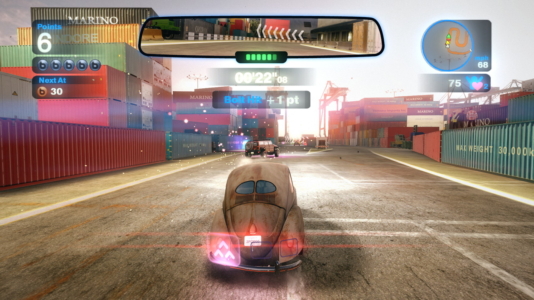
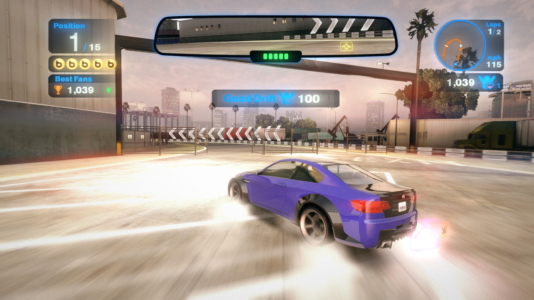
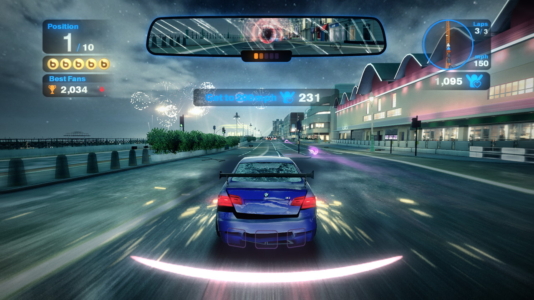
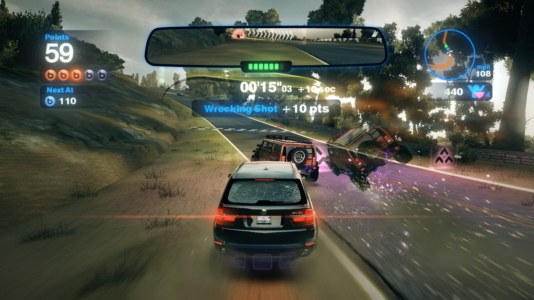

 Posts
Posts
Hi Rick,
I confirm everything you wrote.
Generally, to progress in the game, I apply this tactic: finish in first place in all races, where applicable, then replay the race to improve other target points (fan points, for example).
Destruction mode can be a problem, as you have to balance the speed and endurance of the car, because when enemies take your shots, they release return shots from the rear, which are often difficult to avoid.
However, having almost reached the end of career mode, I left Blur around September of last year and have not played it again, because the points required by the game have become too stringent. My attempts to improve were unsuccessful, so I took a (long) break.
Maybe, I can go back to it these days: I left the link on the desktop, as a reminder.
It’s a well-made game, but it will make you sweat.
P.S.: I’m also looking at Gas Guzzlers Extreme, a game very similar to this one. I played the first one in the series and it left me with good memories.
January 20, 2023 @ 1:07 pm
Hi Oleg,
Medium difficulty was perfectly pitched for me. As I mentioned, there were a few silly fan runs towards the end, but I think I managed to collect all lights overall, with the exception of one random fan target in the middle somewhere.
The last race is tricky, but I found the boss race against the two Skylines the toughest of the game by far.
January 20, 2023 @ 3:23 pm
I just love it when a racing game does not support joystick input nor allow redefinition — the same with Wheelman, by the way, which is thus unplayable by normal humans.
Porting this way is utterly useless.
November 4, 2025 @ 1:50 am